How To Make Yogurt In A Yogurt Maker
Sneak Peek: Learn how to brand Greek yogurt (aka Greek yoghurt) at home with this simple Greek yogurt recipe. You won't demand special equipment. Cheque out the step-by-step instructions and pictures.

As an Amazon Associate, I earn from qualifying purchases.
Making yogurt is easier than y'all recollect. Follow my instructions, and earlier you lot know it, you'll be turning cartwheels over your first successful batch of Greek yogurt.
At start, I wasn't turning cartwheels. I approached making Greek yogurt the same as a high school term paper. I read lots of recipes and tried to boil downwards millions of ideas and traditions into the perfect "recipe." Before long, I was terribly confused. Many people just copied from a friend and when they made 1 good batch of yogurt, they published the directions. Who should I listen to??? Aach!
Information technology turns out that you don't demand a yogurt maker, an expensive incubator, or yards of cheesecloth. I've tried the yogurt maker and cheesecloth already. The yogurt maker is OK for beginners (like a flip phone for cellphone users), merely when you become addicted to homemade yogurt, y'all'll desire more.
The cheesecloth? What a mess! There'due south another way. Stick with me.
The essential tools are persistence, patience, and an appreciation for live cultures. (Beginners will besides find a quick-read thermometer indispensable—more near that later on.)
If y'all prefer to skip the details and answers to questions, click the push button to go directly to the recipe.
Spring to the Yogurt Recipe
If you're on the fence almost whether homemade yogurt is correct for you, hop over to this post for an like shooting fish in a barrel and humorous read nigh "Five Things Yous Should Not Do When Making Yogurt".
What'due south the difference betwixt Greek yogurt and regular yogurt?
Greek yogurt is regular yogurt minus office of the whey. Whey is the yellowish liquid you see collecting on top of yogurt. In many parts of the world, Greek yogurt is called "strained yogurt."
More than differences betwixt regular yogurt and Greek yogurt:
- Thicker than regular yogurt
- Higher in protein and lower in sugar than regular yogurt
- Contains more than fat (unless you make it with non-fat milk) than regular yogurt
The simplest mode to make Greek yogurt is by straining off the whey from regular yogurt. Some companies add gelatin, rennet, or other mystery ingredients to brand information technology thick. The result is often an junior (and cheaper) product.
Something else to annotation from Healthline: "Considering the straining process reduces the total volume, Greek yogurt takes significantly more milk than regular yogurt to make a batch of the same size."
How long does it have to make yogurt?
Now that I have my system down, actual hands-on fourth dimension is less than xv minutes.
But there is hands-off time.
- Heating and cooling the milk: 1-2 hours
- Incubation menses: 5-10+ hours
- Straining yogurt: 1-3 hours
Adding up those hours sounds like an all-day affair. Merely it's similar doing the laundry. You learn how to weave it into your schedule.
Do I need a yogurt maker to make yogurt?
A yogurt maker is easy and foolproof. That's non a bad thing, specially for beginners.
All yogurt makers are non alike.
Many yogurt makers just make individual servings. If yous desire to make Greek yogurt (straining required), they are not practical. Quart-size and larger yogurt makers are better for Greek yogurt lovers.
In the end, you lot don't need a yogurt maker at all. The directions given here will prove yous how to make large and small batches with no special equipment.
How to make yogurt at home:
Pace 1: Make full a heat-safe container with dairy milk (cow's milk or caprine animal milk).
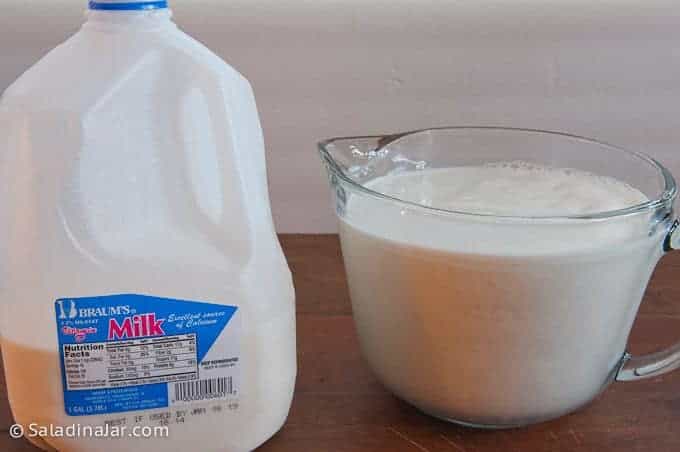
Use a microwave-safety 2-qt. glass batter basin or a larger pyrex dish to estrus milk in the microwave. Or use a large saucepan to estrus milk on top of the stove.
Step ii: Oestrus milk to 170-180˚F.
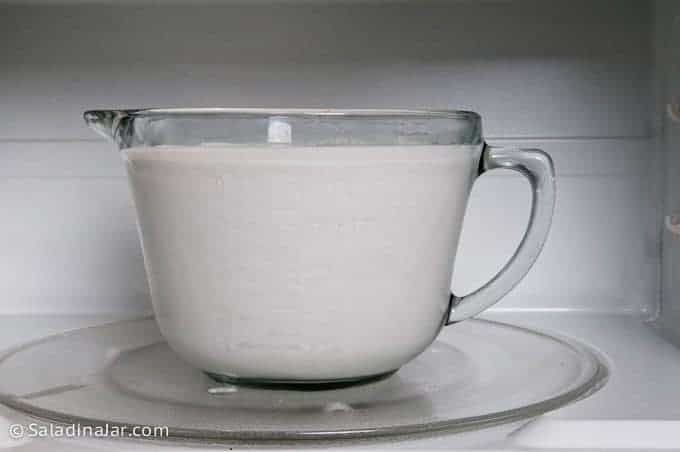
1. Using a microwave to heat the milk:
For ii quarts of milk, rut on HIGH for 16-19 minutes if your microwave is 900 watts or less. If you take a newer full-size oven with over 900 watts of power, oestrus the milk using a lower power (70-80%) for 22-25 minutes. Check the temperature of the milk with a quick-read thermometer until yous know how long information technology takes for the milk to reach the right temperature in your microwave.
Microwaves tin vary wildly. Experiment with yours to see what works all-time. Once you effigy out the perfect timing, brand a note. Yous'll never have to call up about it again.
Why I prefer heating milk with a microwave:
- No worries about the milk humid over and making a mess
- No monitoring is needed once you figure out the perfect timing
- No scorching and the ensuing mess you have to clean upward
- Piece of cake to agree the loftier temperature for fifteen minutes if y'all choose to do that
- Only one muddied dish to wash (+ a strainer if making Greek yogurt)–heat, absurd, incubate, strain, and whisk yogurt in the same drinking glass container
2. Using a stove to heat your milk:
Y'all can also estrus the milk on the stove. Keep the heat turned down to avoid scorching. Stir frequently and check the temperature as you go.
No affair how you heat the milk, avoid boiling. But if your milk does boil, carry on. The milk will all the same brand yogurt, but it may not be equally polish.
iii.What well-nigh usin1000 an Instant Pot?
Some people like to apply their Instant Pot to oestrus and incubate the milk. That's fine if you don't mind babysitting the process.
The disadvantages of making yogurt with an Instant Pot:
- The size of your pot volition limit the amount of yogurt you lot can make.
- Whenever I've tried this, I end up needing my Instant Pot to fix dinner. (This might be related to Spud'due south law.)
The advantages of making yogurt with an Instant Pot:
- Incubation is easy if your model has a preset button.
- Convenient if you are only making a few small jars of yogurt
4. Can I skip the heating step since my milk is pasteurized?
Many people think the only purpose of heating milk is to sterilize it. But the milk has already been "sterilized" in the pasteurization process. The nearly important purpose of heating the milk is to unravel the proteins so the incubation process will event in a thicker yogurt.
Note: If you use Ultra-filtered milk (such every bit Fairlife), y'all exercise not need to heat it. Some people phone call this the "cold start" method.
If you are wondering whether the common cold start method or the traditional method is better for you, don't miss this mail service.
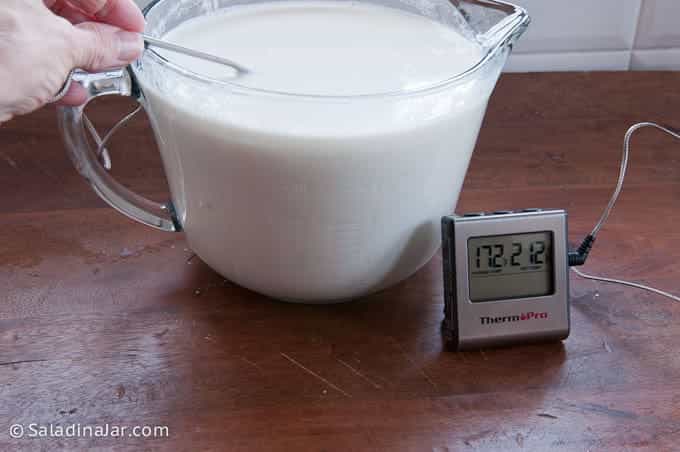
Step 3: Let the milk cool downwardly.
The temperature of the milk needs to drop back to somewhere betwixt 100-110˚F.
Milk that is likewise hot will impale the little yogurt bodies in the starter. Projection over!
Cooling times volition vary depending on the book and type of container holding the heated milk. Use a quick-read thermometer to check the temperature.
Hot Tip: If you are in a bustle, fill up your sink or a tub with h2o and set up the container of milk down into information technology. Add some ice in one case the milk cools downwards a bit.
Don't panic!
If you permit the temperature slide down to 80 or 90˚ F, don't worry. Add your starter and go along equally usual.
Until the temperature returns to 100-110˚F, the yogurt-making political party is delayed, not canceled.
If you don't want to wait or your incubation arrangement doesn't have a steady oestrus source, gently heat the milk back to 100˚ F.
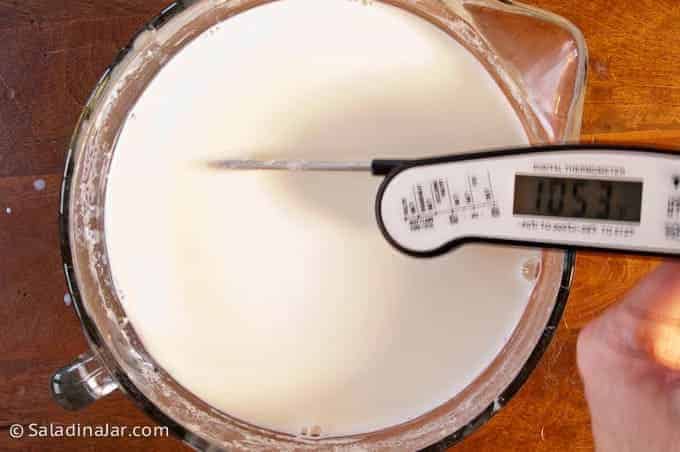
It looks like the temperature of this milk is back up to 105˚F. So, nosotros are ready for the adjacent stride.
Step 4: Add starter to the cooled milk.
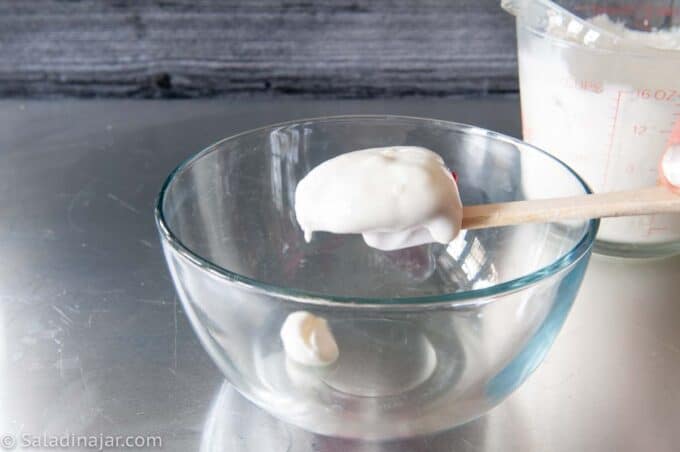
Place a spoonful of yogurt starter into a minor bowl.
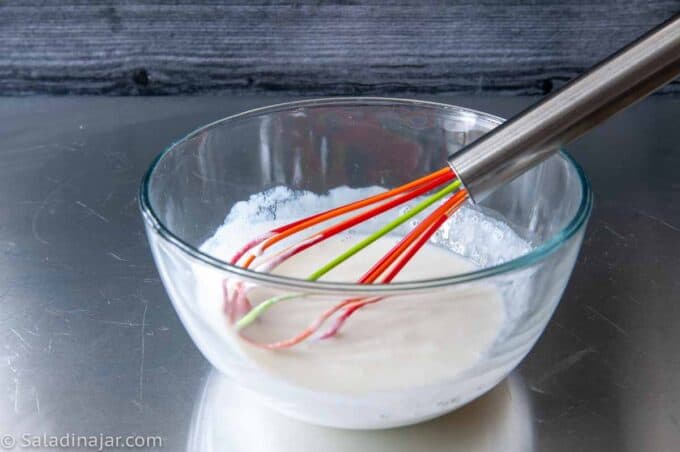
Add cooled milk to the yogurt starter and whisk until shine.
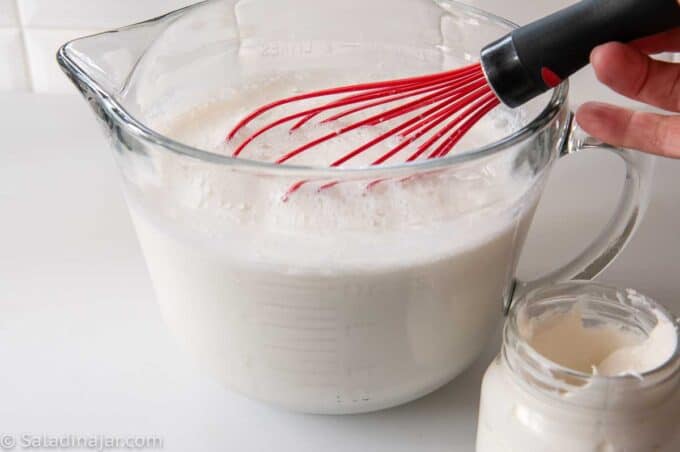
Whisk the starter into the warm milk.
Notation: If you are in a hurry, you can drib a tablespoon of starter direct into the yogurt. I do information technology all the time. Withal, the texture of your finished yogurt may be nicer when you mix the starter with milk before pouring it into the larger container of warm milk.
More than answers to common questions nigh yogurt starters:
1. What's a starter?
A starter contains live yogurt microbes. No starter? No yogurt.
two. Tin can I utilize a jar of my favorite yogurt from the store?
- Aye, if information technology'southward unflavored, fresh, and contains alive cultures (little yogurt bodies).
- Avoid yogurt with additives such every bit gelatin or other thickeners. They can crusade a grainy texture.
- If you can't find unflavored yogurt, vanilla-flavored volition unremarkably work. Just, it's not my first pick.
- Unflavored yogurt from the store:
- Easily available in about every grocery store
- It's relatively inexpensive
- Commonly good for 3-4 generations or more than
- Freeze-dried yogurt starter (aka "traditional starter") comes in a foil packet and costs more. It's bachelor online, in health food stores, or specialty supermarkets like Sprouts.
- A traditional starter is hardier than highly engineered commercial yogurt. Information technology'due south easier to ward off "wild yeast" that can mess up your yogurt.
- A traditional starter is more complicated to use for a beginner. Expect the first batch to be thin. (Follow the directions that come with the starter.)
- Subsequent batches will exist thicker equally the yogurt bodies ramp up to their full potential.
4. Can I use yogurt from a previous batch of homemade yogurt?
- Yes, as long as it is not more than a calendar week to 10 days old.
- If you are using commercial yogurt for a starter, buy a new "starter" yogurt from the store every 3-iv batches.
- "Traditional yogurt starter" tin be used over and over. Some people say it can exist used for years. Brand a fresh batch every 7-10 days for the best results.
5. Do I have to warm upwards the starter before adding it to my cooled-down milk?
Not actually. Little yogurt bodies don't seem to listen jumping straight off the diving board into warm milk. I've made hundreds of batches of yogurt using a refrigerator-cold starter.
6. If I desire to make Greek yogurt, do I have to use Greek yogurt every bit my starter or will regular unflavored yogurt piece of work?
It doesn't matter. Greek yogurt starts life as regular yogurt. Employ whichever you lot accept. Freshness is more important.
7. How much yogurt starter should I utilise?
Utilise a generous tablespoon of yogurt starter per quart of milk. More is not necessarily ameliorate. Yogurt bodies are big eaters and don't similar to be crowded.
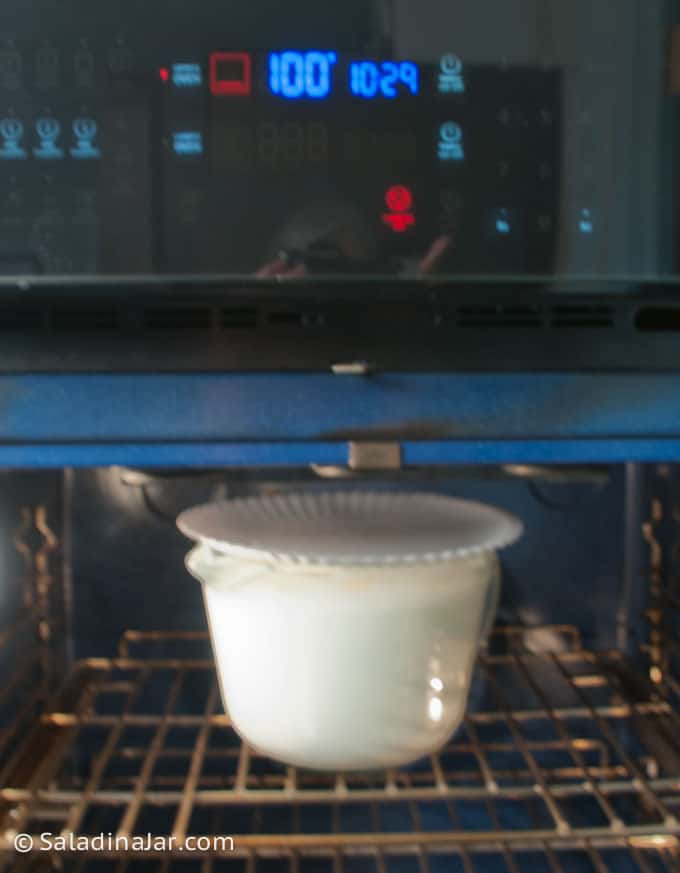
CAUTION: This step is where many people go off the rails. If your incubation organization gets also hot, the picayune yogurt bodies will die. On the other hand, if the milk doesn't stay warm enough, nothing will happen.
Either style, the result will exist milk, not yogurt. If that happens, notice out what to do with failed yogurt hither.
1. What is the all-time way to incubate yogurt?
Short reply: Whatever will hold your milk at a steady 100-110˚F.
Long answer: The possibilities are numerous depending on how your kitchen is gear up, the equipment you already own, and how much milk you are trying to incubate at one time.
See this mail nearly the varied and artistic ways my readers incubate their yogurt. Ideas include:
- Fix your oven on the "dehydrate" or "bread proof" setting
- Wrap the warm milk in a coating and prepare inside an water ice chest
- Run your oven at 350˚F for one minute, then turn off. Wrap warm milk in a towel and set it inside the oven.
- For smaller amounts, some people apply a thermos.
- Use your instant pot on the yogurt setting (see the manual–instructions vary)
- Wrap your milk in a towel and ready it on a heating pad.
- Purchase an electric bread-proofing box (paid link).
- Notice a warm place in your house, such as on summit of the h2o heater.
HOT TIP: When trying out a new method, check the temperature periodically to make sure it is neither too cool nor too warm. Set a loving cup of water next to the milk and bank check the water, not the milk.
2. How long does yogurt need to incubate?
It depends…(Don't you lot hate that answer?)
- Do you prefer tart or balmy yogurt? The longer you lot incubate, the more tart your yogurt volition exist. I usually incubate for iv-6 hours considering I prefer mild yogurt. Some people incubate as long every bit 24 hours when they are concerned about lactose.
three. What is the best temperature for incubation?
- 100-110˚F is optimal. A half-gallon of milk with a fresh and vigorous starter volition fix in 4-i/2 to 6 hours. The yogurt volition taste mild. Incubate longer for a tarter flavor.
- The hotter the temp, the quicker your yogurt will set, and the tarter your yogurt will taste.
- Note that temperatures closer to 115˚F accept a downside:
- The college the incubation temperature, the more than chance that a "skin" will form across the superlative.
- Y'all may see excessive whey on top. Strain it off if you don't desire to stir it back in. (See directions below.)
- Go much college than 115˚F and the little yogurt bodies will die.
Step six: When the yogurt sets, remove it from incubation.
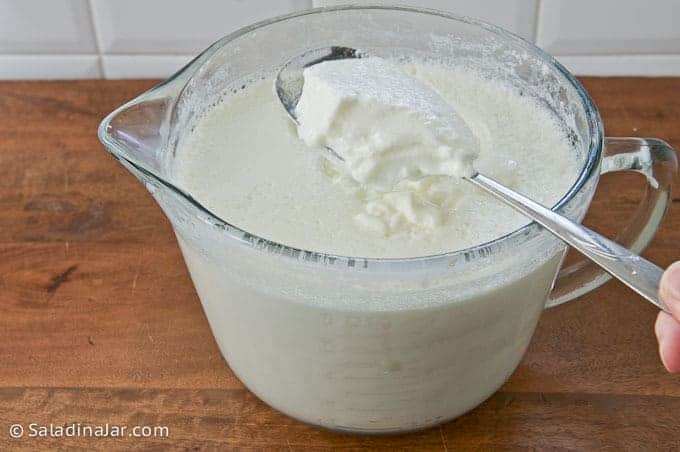
1. How tin I tell if the yogurt is set?
Practiced question and for some, the hardest part of the unabridged process. Yous volition learn from feel when it "looks right."
Finished yogurt should look set — like jello. If yous take a spoonful out of the middle, information technology should stand up on its own.
2. What is the watery liquid I see on top?
There may be a watery and yellowish liquid on superlative called "whey." That'southward normal. Pour off the whey or stir it back in–your option.
If you pour information technology off and want to save it, here are some ideas for what to do with fresh yogurt whey.
Stride seven: Chill yogurt or strain it for thicker Greek yogurt.
At this point, you could chill the plainly yogurt for 2-iii hours, then eat it. Or, you can make information technology thicker (Greek yogurt) by straining it.
How to brand Greek-style yogurt from regular yogurt:
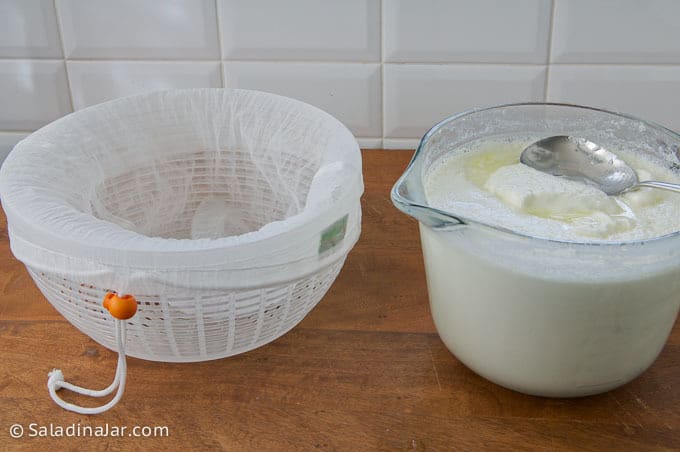
Line a colander with a pouch, cheesecloth, or a java filter).
Hot Tip: The plastic bowl inside a salad spinner works great as a colander. It will agree upwardly to a gallon of milk.
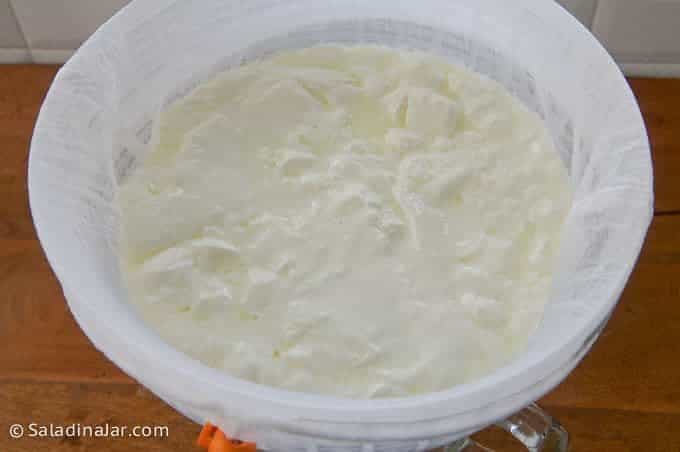
Yogurt will "suspension" when you spoon it out of the original basin. So don't worry if it looks more like cottage cheese.
Stride 2: Let the yogurt bleed until information technology is as thick equally want.
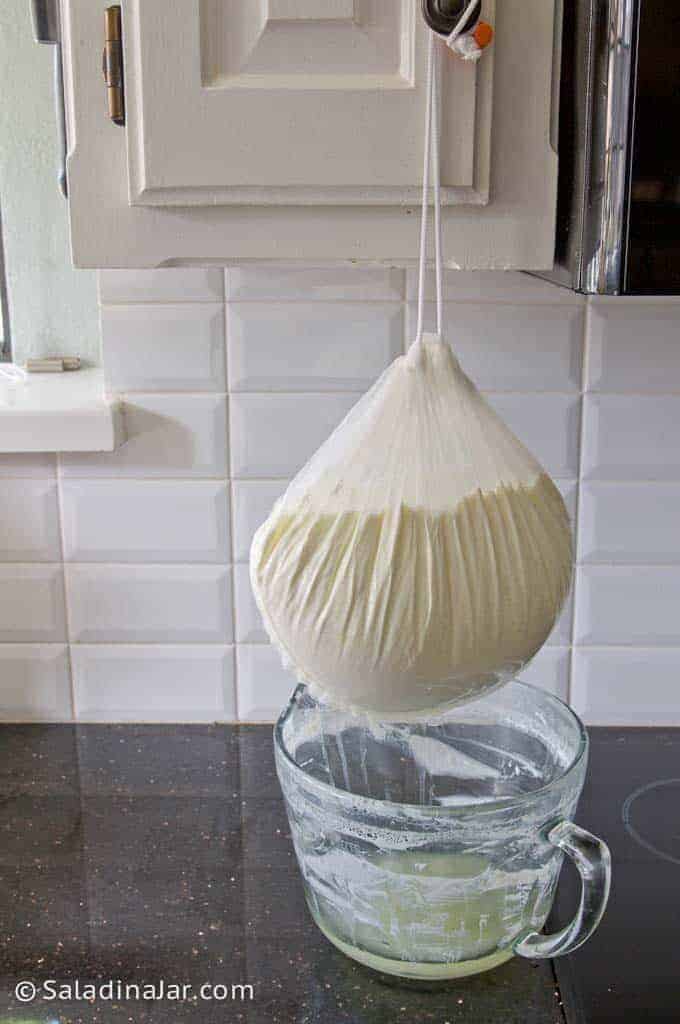
If using a pouch, you tin can pull the pocketbook tight and hang it. If using cheesecloth or a coffee filter, fix the lined colander back over the original bowl to catch any whey that drains off.
The time required to make Greek yogurt will vary according to your method of straining and how thick you prefer your yogurt. The longer you strain, the thicker the yogurt.
If the yogurt is non properly fermented, it will be difficult to strain. When yogurt is too thin, it will immediately run through the cheesecloth or a pouch. When using a java filter, it may just sit at that place. Read this post almost when yogurt fails for what to do next.
Should I refrigerate Greek yogurt while I'm straining it?
Some people say the yogurt should sit in a fridge while information technology is straining. But who has room in their refrigerator for that?
Another 2-iii hours sitting on the counter won't hurt your yogurt (or you). The acidic nature of yogurt protects confronting spoilage.
Step 4: If desired, whisk Greek yogurt until creamy smooth.
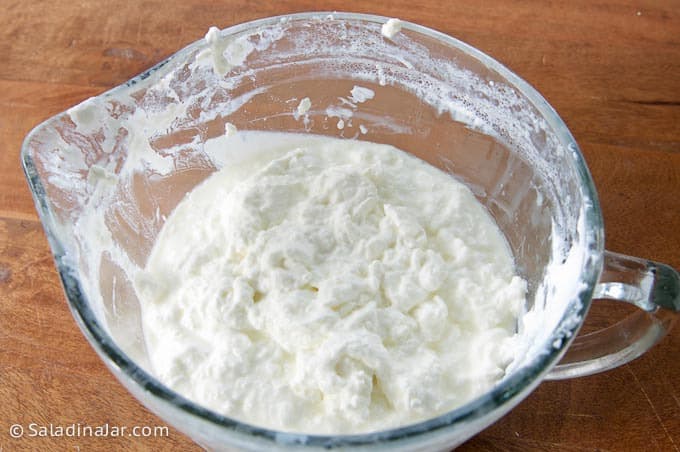
Strained yogurt usually looks curdled similar cottage cheese. That's normal. You can chill and consume equally is or whisk information technology.
When chilled, the texture should feel polish on your tongue. If it doesn't, see the troubleshooting guide below.
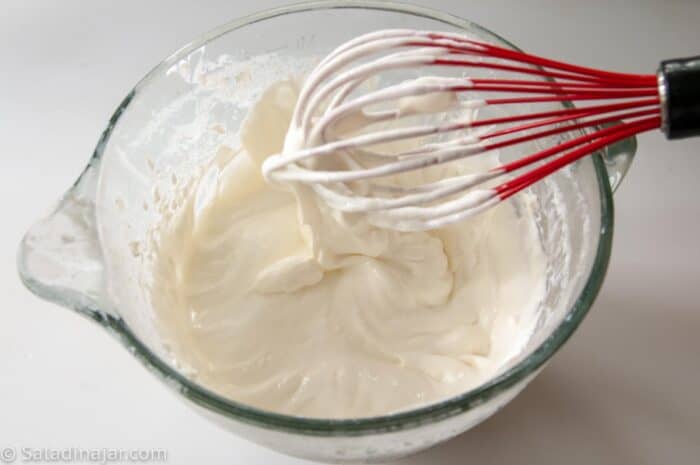
Shell strained yogurt with a big whisk until the lumps disappear. If you are doing a large amount, try using a stand mixer with the whisk attachment. Immersion blenders are too harsh and will make the texture near runny.
FAQ about making yogurt:
Why didn't my yogurt set?
The most mutual cause relates to incubation. If the temperature is not held constantly at 100-110˚F for several hours, the yogurt will non set.
Some other crusade is the starter. It should exist fresh (fabricated within the last seven-10 days), without additives or flavorings.
Why does my yogurt look lumpy?
Information technology's normal for yogurt to expect like cottage cheese once you "pause" the surface. Nevertheless, if it is extreme, y'all may take used also much starter.
But a generous tablespoon or two per ii quarts of milk is necessary. More is not better. Yogurt bacteria dislike being overcrowded. Read this mail service if you're confused about how much starter y'all really need.
Some other cause is letting the milk incubate too long. Fresh yogurt starter in a perfect surroundings can transform warm milk into yogurt within 4-half dozen hours.
How can I make my yogurt creamy?
Whisk information technology vigorously. If you are making Greek yogurt, whisk it later yous have strained information technology.
Practice this past hand or use a wire attachment with a stand mixer. Some immersion blenders and portable mixers come with wire whisks that work great. Don't utilise a blender or food processor as they are also crude on the yogurt and volition cause it to sparse out, fifty-fifty later it'southward chilled.
Why is my yogurt grainy?
It's possible you heated information technology besides rapidly. Likewise, using a yogurt starter with additives can crusade graininess. Read more than about grainy yogurt here.
What are the little bits of "skin" I feel on my tongue when eating yogurt?
You may accept missed some peel attached to the side of the bowl as the milk was cooling.
I've tried several methods to prevent skin from forming. None work without a lot of stirring at the right times.
If the possibility bothers you, check out the cold-start method for making yogurt.
Does this whole process seem besides complicated? Anytime you work with living organisms when making nutrient like bread or yogurt, those yeasty bodies are depending on you to throw the perfect party so they can have fun.
It takes time and a few tries to figure out what those yeasty bodies prefer, especially in your kitchen. Proceed trying. I guarantee that creamy and delicious yogurt is inside your reach. I'll help yous.
If you have any questions or suggestions, email me privately: Paula at saladinajar.com.
Hope to meet you again shortly! Paula

How To Brand Healthy Greek Yogurt
A guide to making your own Greek yogurt at home using fat-complimentary, 1%, 2%, or whole milk.
- 2 quarts milk - fat-free, 2% or whole milk
- 2 tablespoons yogurt - commercial or your own homemade for starter
Prevent your screen from going night
-
Make full a Pyrex 2-qt microwave-safe basin or pitcher with milk. Alternatively, cascade milk into a heavy-duty pot to rut on the stove.
-
Estrus milk in the microwave until bubbling begin to appear effectually the border. The temperature should reach 170-180˚F after y'all stir it. (In my new microwave, information technology takes 25 minutes on 70% power). Monitor the temperature closely until you figure out the best time and power for your microwave.
-
If you adopt thicker yogurt, an optional step is to hold the temperature at 180˚F for 15-20 minutes. (I do this in my microwave for 15 minutes on 20% power.)
-
Remove the milk from the heat source and stir it. If a skin has formed, remove it.
-
Let your milk to cool until the temperature drops to between 100-110˚F. Utilize an water ice water bath to hasten the process, if desired.
-
Add a modest amount of cooled milk to 1-2 tablespoons of fresh unflavored yogurt every bit a starter. (You may use yogurt from a previous batch of your ain homemade yogurt.) Whisk until the starter is smooth.
-
Cover the milk and place it in a warm environment where the temperature stays effectually 100-105˚F.
-
Allow the inoculated milk to incubate for 4-8+ hours or until set like gelatin.
-
At this betoken, yous could chill the yogurt and eat it as is. Or you can decide whether to pour off the whey or stir it back in. Straining yogurt to brand information technology thicker will event in Greek yogurt.
Making Greek Yogurt from Regular Yogurt
-
Very carefully pour yogurt into a wet burgoo strainer or chinois. If the mesh is fine enough, you lot won't need to use a cheesecloth or paper towel. Or use a double layer of commercial-size paper coffee filters inside a cheap colander. (This is my current favorite method of straining.)
-
Allow yogurt sit in the strainer until the yogurt is reduced by approximately a 3rd. Time volition vary according to the thickness of the yogurt out of the oven and your own preference regarding texture and sourness.
-
Empty whey from the concoction bowl and pour yogurt out of the strainer back into the original bowl. Utilize a good whisk to beat until smoothen. Thin with milk or leftover whey if yogurt is too thick.
-
At present is the best time to add any flavorings or sweeteners, if desired. Otherwise, add extras before you are ready to eat.
-
Chill. This will stay fresh in the refrigerator for at least ii weeks.
Nutritionals are but an judge. Numbers will vary according to how much y'all strain your yogurt and the type of milk you lot apply.
Nutrition Facts
How To Make Healthy Greek Yogurt
Amount per Serving
% Daily Value*
* Percent Daily Values are based on a 2000 calorie diet.
How To Make Yogurt In A Yogurt Maker,
Source: https://saladinajar.com/yogurt/healthy-homemade-greek-yogurt/
Posted by: smithanabrons.blogspot.com

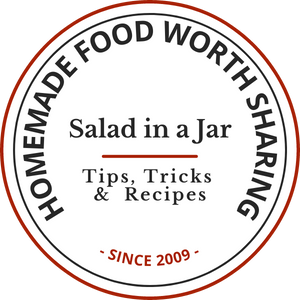

0 Response to "How To Make Yogurt In A Yogurt Maker"
Post a Comment